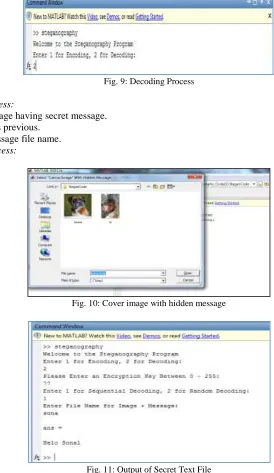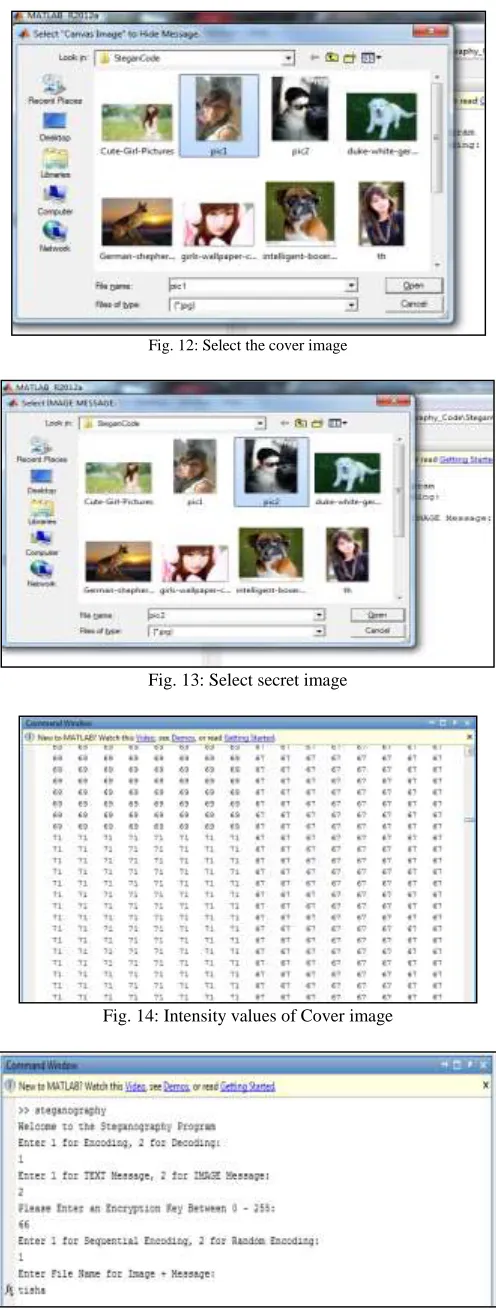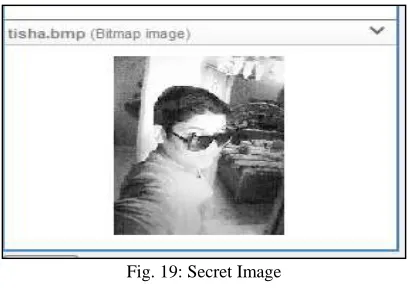An Optimization of Text and Image
Steganography using LSB Technique
Sonal Kamal Kumar Ranga
M. Tech Scholar Assistant Professor
Department of Computer Science & Engineering Department of Computer Science & Engineering GITAM Kablana, Jhajjar(Haryana) GITAM Kablana, Jhajjar(Haryana)
Abstract
In the area of communication, security is the most important issue now days. There are number of malicious users try to hack the information. Most probably of data security and data hiding algorithms have been developed. To keep the information secure various techniques are used. Steganography is one of the most widely used data security algorithm. It is the process of transferring top secret information in a way that no one else can detect the presence of any secret information. For higher security steganography algorithm is used to combine with Encryption/decryption algorithm. Steganography can be of various kind. This paper shows the both Text and Image Steganography implementation.
Keywords: Text Steganography, image Steganography, Data Hiding, Stego Image, Encoding, decoding. LSB Technique ________________________________________________________________________________________________________
I. INTRODUCTION
Steganography:
Steganography is used to hide the message so there is no knowledge of the existence of the message in the first place. If a person or persons views the object that the information is hidden inside of he or she will have no idea that there is any hidden information, therefore the person will not attempt to decrypt the information [1].
The structure of Steganography designed by using three components: the “cover medium”,” the hidden message”, and” the secret key”. The cover medium can be a painting, a digital image, an mp3, even a TCP/IP packet among other things.
The cover medium is the object that will “carry‟ the hidden message. A key is used to decode/decipher/discover the hidden message. The following formula provides a very generic description of the pieces of the stenographic process:
Cover medium + hidden data + stego key = stego medium
Here, the cover_medium is the file in which we will hide the hidden_data, which may also be encrypted using the stego_key. The resultant file is the stego_medium [2] (which will, be the same file as the cover_medium). The cover_medium (and, thus, the stego_medium) are typically image or audio files.
If a hidden message is encrypted, it must also be decrypted if discovered, which provides another layer of protection.
Fig. 1: Basic Concept of Steganography
Types of Steganography:
There is different kind of steganography: 1) Text Steganography
Fig. 2: Categories of SteONption
II. CONCEPT OF ENCRYPTION AND DECRYPTION
Encryption:
In Encryption “The original image is in the form of RGB which is converted into a matrix of pixels having 256*256 size. Each image has intensity values for every pixel. Thus these intensity values form our matrix. Here, the user must want to select the key for encryption process between 0-255 which will be used for further process.
Decryption:
The simple embedding process is decrypted by communicating the pixel, as well as the bits used to hide the image and the matrix size of the hidden image. This information would act as the decryption key for the simple method. In decryption process the encryption key must be same as the key used for encrypting the image.
III. PERFORMANCE ANALYSIS
Time Efficiency Analysis:
If an algorithm is not time efficient it doesn’t matter how strong it is. Proposed algorithm must be time and energy efficient. So, that we can say that it is a greener algorithm and consume less energy as compared to the existing one. There are many encryption/decryption algorithms, but still there is always a competition to develop an algorithm which will provide high security in minimum time. Time and robustness of internal structure both are the important parameters for any algorithm.
Throughput:
As time efficiency is an important parameter used to measure the performance of steganographic algorithm but, throughput is another parameter depended on time. It can be defined as the amount of text encrypted per unit time. The algorithm having higher throughput is considered better than the other.
IV. OPTIMIZED ALGORITHM
The algorithm that i have proposed in this system is basically an extension of the original LSB. In this algorithm Instead of hiding the data in least significant bits of the RGB components of a pixel, we convert every character in ASCII code and then we hide data as shown below: -
Let the data to be hidden is word “HELO SONAL”
ASCII code of H= 72 and corresponding binary is 01001000.
ASCII code of E= 101 and corresponding binary is 01100101.
ASCII code of L= 108 and corresponding binary is 01101100.
ASCII code of O= 111 and corresponding binary is 01101111.
ASCII code of S=115 and corresponding binary is 01110011.
ASCCII code of O=111 and corresponding binary is 01101111
ASCII Code of N=110 and corresponding binary is 01101110
ASCII code of A=97 and corresponding binary is 01100001
Least Significant Bit (LSB) to ASCII Conversion:
8 bits are used for the representation of characters in ASCII code .The LSB algorithm is used to insert the bits of the hidd en message into Least Significant Bits of the pixels. This method is used to embed the significant amount of the information with no visible degradation of the cover image. One major advantage of the LSB algorithm is that it quick, easy to work .
Process of Embedding a Message:
The process of embedding data to the pixels of an image is a multistep process. The ASCII character stream is split into two bit pairs. Here, embedding of message is doing through column by column from left to Right Direction. Finally the inver se process is applied to reconstruct the image.
Encoding a Message in the Image:
The ASCII character stream is split into 4 two-bit pairs per character. The 2 LSBs of a pixel is replaced with these two bit pairs. These two bit pairs are then stored in an array for manipulating later. Then the lifting scheme is applied to the image. Lifting scheme is applied three times because the image is split into 3 colour channels. The program then automatically adjusts the encoding according to the decomposition level of LSB . The LSB will Encode the message from Left to Right direction through Column by column.
Decoding of the Message:
The flow of this process starts in the same way as the encoding process. The program splits the image into its colour channel and then applies the replacement of bits from Right to Left to each channel. When the replacement is completed the original message is retrieved out of the pixels of the cover image.
V. PROPOSED WORK
This work is shown only through Sequential Encoding and Decoding for both Text and Image Steganography.
Image to Text Steganography Implementation
Encoding
Here, firstly we select the image for i.e. “canvas image” on which we hide the secret message. a) Convert the image into Matrix:
Here the image will be converted into the matrix of size 256*256 matrix. In this process the original image is selected from the computer and then it will be converted into Matrix form.Where each pixel has their own intensity values.
Fig. 3: Select the type of process
Fig. 4: Cover Image Selection from computer
b) Embedding Process:
After converting the image into matrix form now we embed the secret message with the image which is a text file.
Fig. 6: Select the type of Encoding process
Fig. 7: Secret Message File
Fig. 8: Stego Image
Proposed Encoding Technique:
Inputs for Encoding Process:
1) Browse the cover image i.e. “canvas image” which is of any kind of format i.e. jpg, gif, png, bmp etc . 2) Browse the text file which you want to hide.
3) Enter the secret key i.e. “Encryption key”. 4) Select the type of Encoding.
5) Enter image + message file name by which stego image will be generated.
Output of Encoding Process:
1) Stego Image with .bmp extension.
Decoding
Here, we decrypt the secret message which is encoded into the original or Canvas Image.
Fig. 9: Decoding Process
Input for Decoding Process:
1) Browse canvas image having secret message. 2) Enter secret key as previous.
3) Enter image + message file name.
Output of Decoding Process:
1) Secret message.
Fig. 10: Cover image with hidden message
Fig. 11: Output of Secret Text File
Image to Image Steganography Implementation
Encoding
Inputs for encoding Process:
1) Browse the cover image i.e. “canvas image” which is of any kind of format i.e. jpg, gif, png, bmp etc . 2) Browse another image file which you want to hide.
3) Enter the secret key i.e. “Encryption key”. 4) Select the type of Encoding.
5) Enter image + image message file name by which stego image will be generated.
Output of Encoding Process:
1) Stego Image with .bmp extension.
Fig. 12: Select the cover image
Fig. 13: Select secret image
Fig. 14: Intensity values of Cover image
Fig. 16: Stego Image
Decoding
Here, we decode the secret image which is encoded into the original or Canvas Image.
Input for Decoding Process :
1) Browse canvas image having secret message. 2) Enter secret key as previous.
3) Enter image +image message file name.
Output of Decoding Process:
1) Intensity value of each pixel of secret image in the form of a matrix. 2) Secret image with .bmp extension.
Fig. 17: Cover Image with hidden message
Fig. 19: Secret Image
VI. CONCLUSIONS
This research provides a very nice solution for information hiding of Text and Image steganography using Least Significant bit technique. In this paper we use the process of Encode the data or image for data hiding by using a secret key. At the receiver side by using Inverse process we use decoding process for getting the secret data which can be either a text file or an image. In this paper both original image and hidden data can be successfully extracted. It can use multiple formats of image for steganography process. This work provides a very fast, programmable and cost effective hardware solution in the area of secure communication.
REFERENCES
[1] Dipesh G. Kamdar1, Dolly Patira, Dr. C. H. Vithalani “Dual Layer Data Hiding Using Cryptography and Steganography” International Journal of Scientific Engineering and Technology, Volume No.1, Issue No.4, pg :134-138, ISSN : 2277-1581, 01 Oct. 2012
[2] Pratap Chandra Mandal, “Modern Steganographic technique: A survey”, International Journal of Computer Science & Engineering Technology, Vol.3, pp. 444-448, September 2012.
[3] M. Kavitha, K. Kadam, A. Koshti, P. Dungha, Steganography Using Least Signicant Bit Algorithm, International Journal of Engineering Research and Applications (IJERA), 2(3), 2012, 338-341
[4] Shilpa Gupta, Geeta Gujral and Neha Aggarwal, “ Enhanced Least Significant Bit algorithm For Image Steganography”, International Journal of Computational Engineering & Management, ISSN (Online): 2230-7893, Vol. 15 Issue 4, July 2012.
[5] Shamim Ahmed Laskar and Kattamanchi Hemachandran, “High Capacity data hiding using LSB Steganography and Encryption”, International Journal of Database Management Systems, Vol.4, No.6, December 2012.
[6] Mukesh Garg and A.P. Gurudev Jangra, “An Overview of Different Type of Data Hiding Scheme in Image using Steganographic Techniques”, International Journal of Advanced Research in Computer Science & Software Engineering, ISSN: 2277 128X , Volume 4, Issue 1, January 2014. [7] Mukesh Garg and A.P. Gurudev Jangra, “An Overview of Different Type of Data Hiding Scheme in Image using Steganographic Techniques”,
International Journal of Advanced Research in Computer Science & Software Engineering, ISSN: 2277 128X , Volume 4, Issue 1, January 2014. [8] T. Morkel, J. H. P. Elloff, M.S. Olivier, “An Overview of Image Steganography”.






